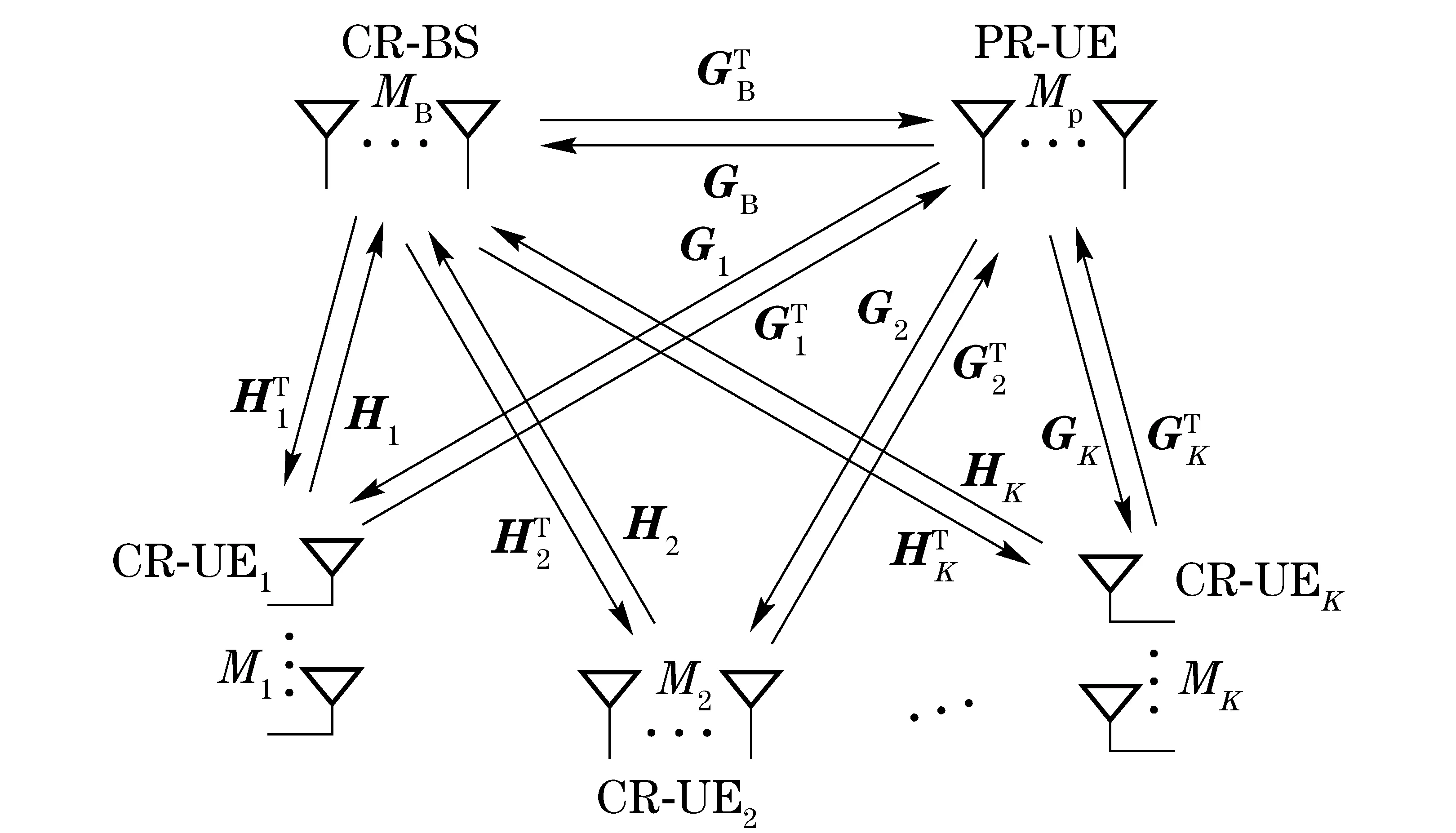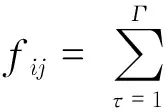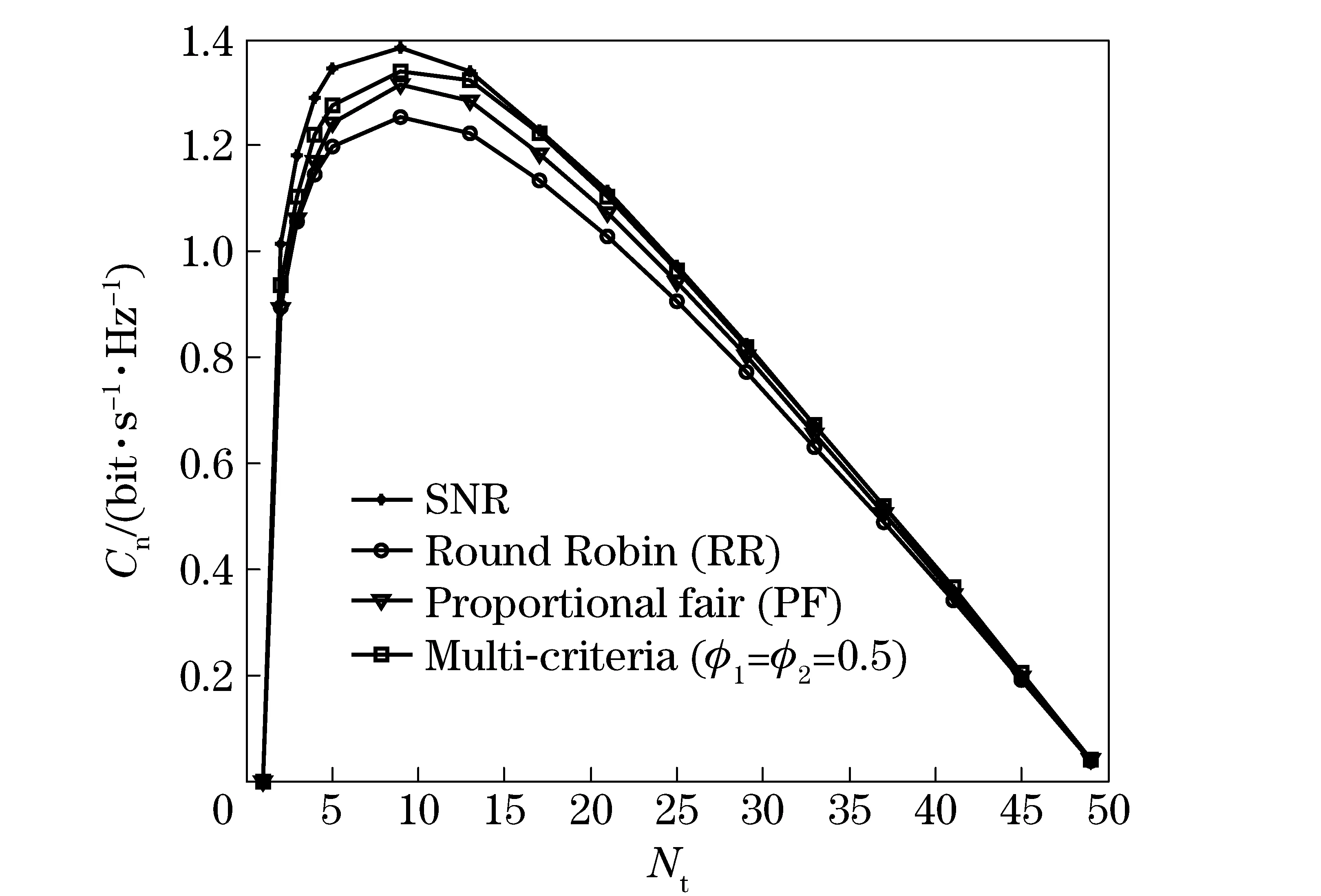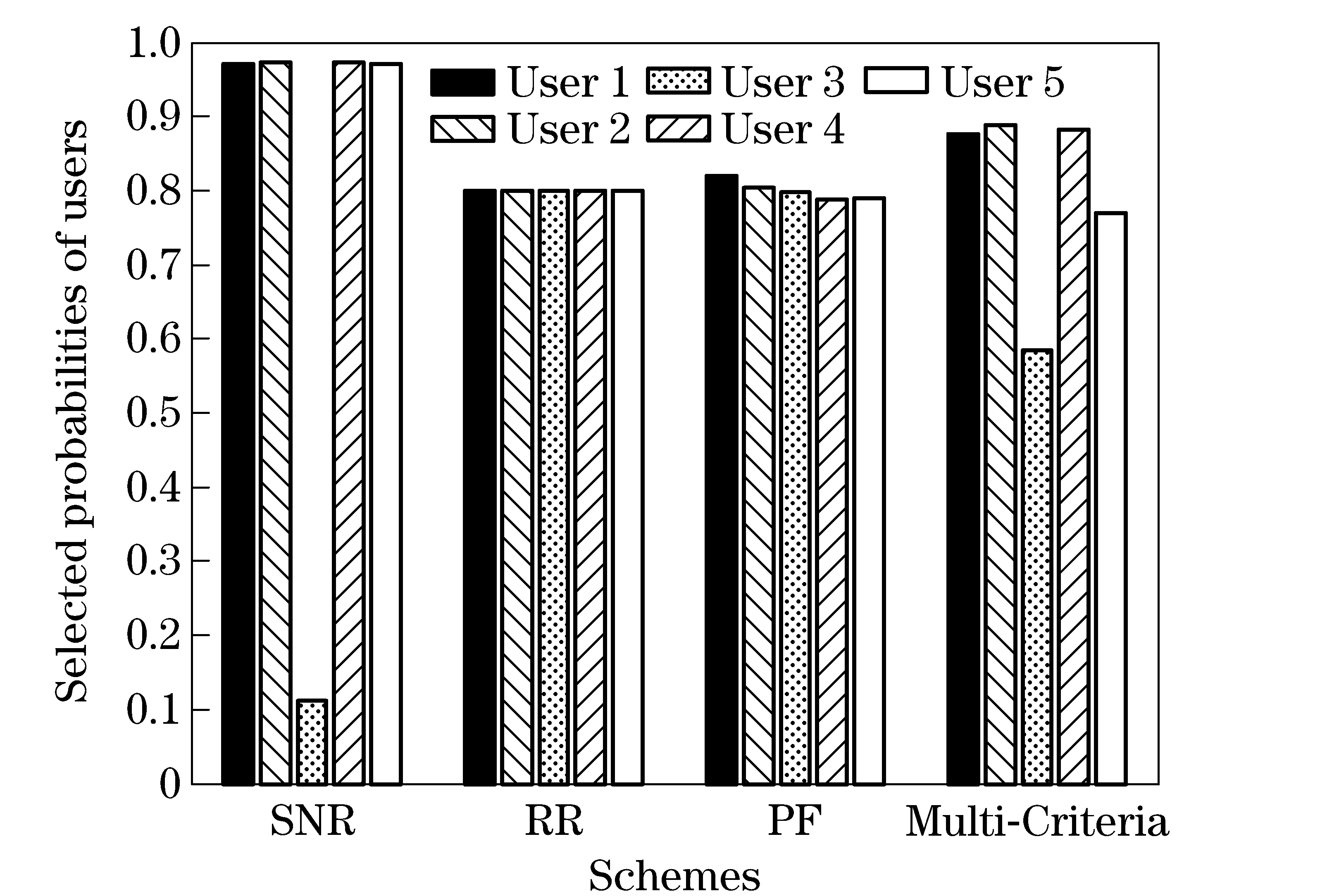Multi-criteria user selection scheme for learning-based multiuser MIMO cognitive radio networks
WANG Ni-wei(王妮煒), FEI Ze-song(費(fèi)澤松), XING Cheng-wen(邢成文),NI Ji-qing(倪吉慶), KUANG Jing-ming(匡鏡明)
(School of Information and Electronics, Beijing Institute of Technology, Beijing 100081, China)
?
Multi-criteria user selection scheme for learning-based multiuser MIMO cognitive radio networks
WANG Ni-wei(王妮煒), FEI Ze-song(費(fèi)澤松), XING Cheng-wen(邢成文),NI Ji-qing(倪吉慶), KUANG Jing-ming(匡鏡明)
(School of Information and Electronics, Beijing Institute of Technology, Beijing 100081, China)
For multiuser multiple-input-multiple-output (MIMO) cognitive radio (CR) networks a four-stage transmiision structure is proposed. In learning stage, the learning-based algorithm with low overhead and high flexibility is exploited to estimate the channel state information (CSI) between primary (PR) terminals and CR terminals. By using channel training in the second stage of CR frame, the channels between CR terminals can be achieved. In the third stage, a multi-criteria user selection scheme is proposed to choose the best user set for service. In data transmission stage, the total capacity maximization problem is solved with the interference constraint of PR terminals. Finally, simulation results show that the multi-criteria user selection scheme, which has the ability of changing the weights of criterions, is more flexible than the other three traditional schemes and achieves a tradeoff between user fairness and system performance.
learning-base; multiple-input-multiple-output(MIMO); cognitive radio (CR) network; multiuser
Current wireless networks are characterized by a static spectrum allocation policy, but it faces the scarcity of frequency spectrum, which limits the development of future wireless communication systems. Recently,cognitive radio (CR) has drawn intensive attentions from both academic and industrial communities[1]. In CR systems, CR users (CR-UE) and primary users (PR-UE) are allowed to share the same spectrum, which is divided into two spectrum sharing policies, i.e., overlay spectrum sharing and underlay spectrum sharing[2].
It is obvious that frequency spectrum is used more efficiently by above technologies, but the performance for PR systems should not be ignored. In addition, the interference at PR-UEs caused by CR-UEs must be effectively reduced and limited by a predefined interference threshold. An efficient technique in CR networks is that the CR transmitters equipped with multiple antennas exploit the beamforming technique to steer the transmit energy to the intended users[3-4]. As we all known, beamforming can be interpreted as a spatial filter and its implementation is usually based on channel state information (CSI). Unfortunately, PR terminals have no responsibility to transmit pilots to CR terminals, so blind channel estimation algorithms will be preferred to gain the CSI between PR terminals and CR terminals[5].
To make the underlay spectrum sharing most efficient, environment learning[6-8]is exploited in this paper, which blindly estimates the null spaces of the PR-UEs without implicit information exchange and additional communication overhead. In this paper, the time of each CR frame is fixed. Learning-based algorithm is adopted to estimate the CSI between PR terminals and CR terminals, and channels between CR terminals can be obtained through channel training stage. For user selection stage, a multi-criteria user selection scheme is proposed to choose the best user set for service. With selected users, the total capacity is maximized by constrained to the interference to PR-UEs, which was solved with a closed power allocation solution. The results show that the multi-criteria user selection scheme, which can change the weights of criterions, is more flexible than the other three traditional schemes and achieves a tradeoff between user fairness and system performance.
1 System model
In our work, the PR system and the CR system share the same frequency band as shown in Fig.1. For the PR system, each PR-UE is equipped withMpantennas and communicates with the PR base-station (PR-BS) without considering the transmission of the CR system. The CR system has a CR base-station (CR-BS) withMBantennas andKCR users (CR-UEs) withMi(i=1,…,K) antennas. In order to use learning method better, we assumeMp Fig.1 Multiuser MIMO CR network As shown in Fig.2, the CR transmission strategy can be divided into frames with fixed timeN=Nl+Nt+Ns+Nd, which has four stages, i.e., learning, channel training, user selection and data transmission stage. It is obvious that the last stage brings more data transmission and system throughput, while the others provide better transmission quality. Therefore, it is important to design the length of different stages and the details are described in the following subsections. Fig.2 CR frame structure 2.1 Learning stage It is knowh that the PR system has no responsibility to report its transmission to the CR system, so the CR terminals have to listen to the PR system and find the noise space of the transmitted signals. After this period of time, CR transmitters precode the transmitted signals by multiplying the noise space to reduce interference to the PR system, while CR receivers reduce interference from the PR system by multiplying noise space after receiving their targeted signals. At symbol periodn, the signals sent from the PR user can be expressed as sp(n),n=1,2,…,N (1) wheresp(n)isanindependentidenticallydistributedrandomsignal.ThenthesignalsreceivedattheCRterminalscanbeformulatedas yB(n)=GBsp(n)+zB(n),for the CR-BS yi(n)=Gisp(n)+zi(n),for the CR-UE, n=1,2,…,Nl (2) The covariance matrices of received signalsyBandyicanbeexpressedas (3) Inordertogainthenoisespace,theEVDofcovariancematricesRBandRiareformulatedas (4) Ifthelearningtimeislongenough,thenoisespacewillbeabsolutelyaccurate.Therefore,theinterferencecanbetotallyeliminatedatCRterminalsasbelow (5) If the signals transmitted at CR terminals ared(n),theinterferenceatPRterminalswillalsoreducetozero (6) 2.2Channeltrainingstage Thechanneltrainingstageisdesignedindownlinktransmissionwithtwogoals,i.e.,obtainingchannelmatricesandprovidingfeedbackofsignalnoiseratio(SNR)toCR-BS. WeassumeCR-BStransmitstrainingsequencest(n)toallusersatthesametime,sothesignalreceivedatithCR-UEis (7) Because the training time is finite and the channel environment is complex in real transmission, estimation error is existed in general. We use the LMMSE-based channel estimator forWianditcanbeobtainedas (8) where (9) Thus, the practical signals received at the CR-UEs can be reformulated as (10) (11) Inordertochooseabetteruserset,weneedtoknowtheSNRofeachuser,whichcanbeexpressedas (12) wheren=Nl+1,…,Nl+Nt. We assume that the channel is quasi static in one CR frame, so the average SNR during the channel training stage can be written as (13) wheretr(TTH)=NtPBS. 2.3 User selection stage Because a CR-BS cannot serve all the CR-UEs simultaneously a user selection method is necessarily needed andKoptusers can be supported at most before data transmission. A user can be more easily selected with largerfi, which is the user selection function of theithuser. Firstly, three traditional user selection schemes are introduced. For the SNR scheme, the user selection function is defined as (14) Then,bydefiningtheselectedtimesoftheithuser as δi,theuserselectionfunctionofRoundRobin(RR)schemecanbeformulatedas fi=i+ΔiK (15) The last traditional scheme is proportional fair (PF) with user selection function described as (16) However, users usually have different requirements in real systems, so a multi-criteria user selection method is proposed. Assume that there are Γkindsofcriterionsandapriorityfunctionofithuserrelativetojthuserisdefinedas (17) (18) Thesameaschanneltrainingstage,CR-BStransmitstheselectedusersettoallCR-UEsthroughfeedbackchannelsfinally.Withinfinitecapacity,thereisnoadditionerror.Inaddition,duetothegreatcomputingabilityofCR-BSitisreasonabletoassumeNB=1. 2.4 Data transmission stage (19) whereKois the number of selected users,v(n)istheeffectiveinterference-plus-noiseterm.Notethat,notonlytheinterferencefromtheCRtothePRbutalsothatfromthePRtotheCRhasbeencontrolled. Beforechanneltrainingstage,CR-BSdoesnotknowthechannelstateinformation,sothepowershouldbeallocatedequally, (20) wherePBis the transmit power of CR-BS. Thus, Eq.(11) can be reformulated as (21) Consideringtheimperfectchanneltraininganduserselectionschemes,weaimtoallocatethepowerofbeamsforeachCR-UEtomaximizethesystemcapacity.Theoptimalproblemis (22) Thecapacityinthedatatransmissionstageis (23) where the covariance matrix defined as (24) then the capacity in Eq.(23) becomes (25) where Λi=diag{λi,1,λi,2,…,λi,(Mi-Mp)} diag{xi,1,xi,2,…,xi,(Mi-Mp)} (26) In order to optimize the total capacity, two stages are proposed. ① For a fixedNt, we use water-filling algorithm[9]to allocate the power and the solution is that if ρei∈(qi,c-1,qi,c],then (27) where (28) ②Basedontheoptimalpower,wesearchfortherangeofNtto find the maximal capacity, which has the final optimal solution. In the simulation, the CR network has one PR-UE withMp=2 antennas, one CR-BS withMB=4 antennas andK=5 CR-UEs withM1=…=MK=4 antennas. In a transmission,Ko=4 users can be transmitted simultaneously at most. When the total time of a CR frame isN=60, the learning stage can be stable withNl=10[7]. According to the standard of LTE, we setPB=1,PU=0.2. In the simulation, we assume that user 3 has bad channel state, i.e. it is far away from the CR-BS or the interference cannot be dismissed. We put all these factors as a part of noise, so the noise power vector is ={1,1,5,1,1}. Fig.3 shows that SNR scheme has the best performance, while RR scheme has the worst performance because of considering fairness only. PF scheme is a little better than RR scheme because it takes both fairness and system performance into consideration. However, multi-criteria scheme considers both aspects with the same weightφ1=φ2=0.5 and outperforms RR scheme. In addition, multi-criteria is more flexible and can achieve different levels of performance by changing the weights. As Fig.4 illustrated that user 3 is selected barely while the other users are selected frequently in SNR scheme, which causes great unfairness between users. Although some users have bad channel conditions, they may still transmit important information, i.e., emergency calls. Obviously, the other three schemes are better programed in this case except SNR scheme. In fact, the emergency incident does not occur frequently, so in most cases the system performance is more important than fairness. To sum all, multi-criteria scheme fits the practical situation and has a trade off between both sides. Fig.3 Total capacity for the four schemes verses Nt Fig.4 Selected probabilities of users for the four schemes In this paper, we have proposed a multi-criteria user selection scheme which provides the best service user set for the learning-based multiuser MIMO CR networks. In addition channel training is exploited to gain the channels between CR terminals. The total capacity is maximized with the interference constraint at PR-UEs. Simulation results demonstrate that the multi-criteria user selection scheme achieves a tradeoff be-tween user fairness and system performance than SNR, RR and PF schemes. Moreover, it is more flexible by changing the weight of criteria. [1] Liang Yingchang, Chen Kwangcheng, Li Geoffrey Ye, et al. Cognitive radio networking and communications: an overview [J]. IEEE Transactions on Vehicular Technology , 2011, 60(7): 3386-3407. [2] Zhao Qing, Sadler B M. A survey of dynamic spectrum access[J]. IEEE Signal Processing Magazine, 2007, 24(3): 79-89. [3] Tajer A, Prasad N, Wang Xiaodong. Beamforming and rate allocation in MISO cognitive radio networks[J]. IEEE Transactions on Signal Processing, 2010, 58(1): 362-377. [4] Hamdi K, Zarifi K, Ben Letaief K, et al. Beamforming in relay-assisted cognitive radio systems: a convex optimization approach [C]∥IEEE International Conference on Communications (ICC), Kyoto, Japan, 2011. [5] Noam Y, Goldsmith A J. Blind null-space learning for spatial coexistence in MIMO cognitive radios[C]∥IEEE International Conference on Communications (ICC), Ottawa, Ontario, Canada, 2012. [6] Zhang Rui, Gao Feifei, Liang Yingchang. Cognitive beamforming made practical: effective interference channel and learning-throughput tradeoff [J]. IEEE Transactions on Communications, 2010, 58(2): 706-718. [7] Gao Feifei, Zhang Rui, Liang Yingchang, et al. Design of learning-based MIMO cognitive radio systems[J]. IEEE Transactions on Vehicular Technology, 2010, 59(4): 1707-1720. [8] Li Shuo, Fei Zesong, Xing Chengwen, et al. Joint resource allocation for learning-based cognitive radio networks with MIMO-OFDM relay-aided transmissions[C]∥IEEE Wireless Communications and Networking Conference (WCNC), Shanghai, China, 2013. [9] Boyd S, Vandenberghe L. Convex optimization[M]. Cambridge, UK: Cambridge University Press, 2004. (Edited by Cai Jianying) 10.15918/j.jbit1004- 0579.201524.0216 TN 929.5 Document code: A Article ID: 1004- 0579(2015)02- 0240- 06 Received 2014- 03- 18 Supported by National S & T Major Project of China (2013ZX 03003002-003) E-mail: feizesong@bit.edu.cn

2 Transmission design and problem formulation









3 Problem optimization

4 Simulation results


5 Conclusion
 Journal of Beijing Institute of Technology2015年2期
Journal of Beijing Institute of Technology2015年2期
- Journal of Beijing Institute of Technology的其它文章
- Numerical simulation of effects of operating conditions on the molecular weight of polypropylene using a response surface method
- Efficient and fair resource allocation in downlink OFDMA systems
- Effect of cutting speed on residual stress of special coating during remanufacturing
- Un-powered gliding aircraft’s ballistic missile optimal design
- Quantification of CP4-EPSPS in genetically modifiedNicotianatabacum leaves by LC-MS/MS with 18O-labeling
- Investigation on experimental method of low-impedance materials using modified Hopkinson pressure bar
